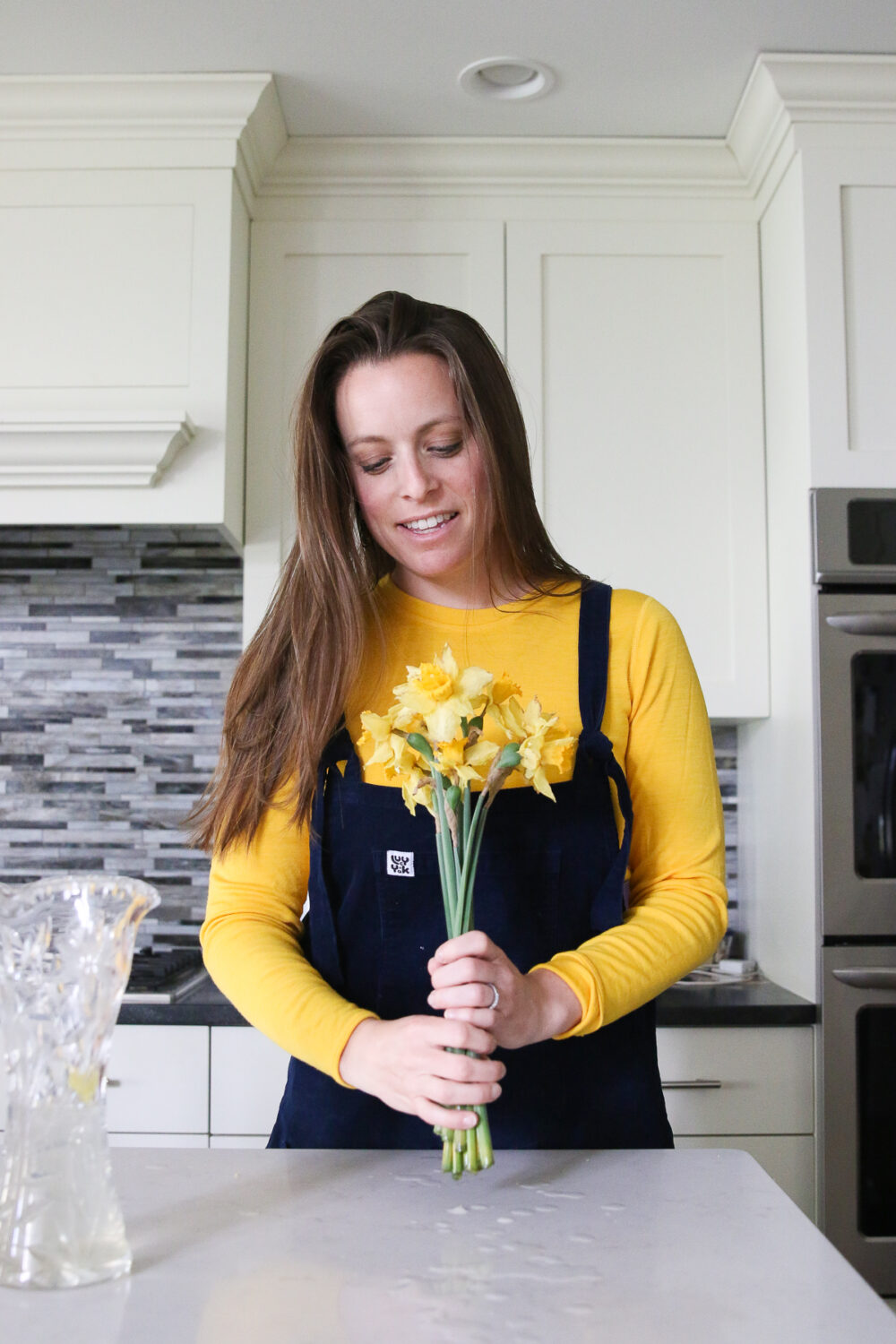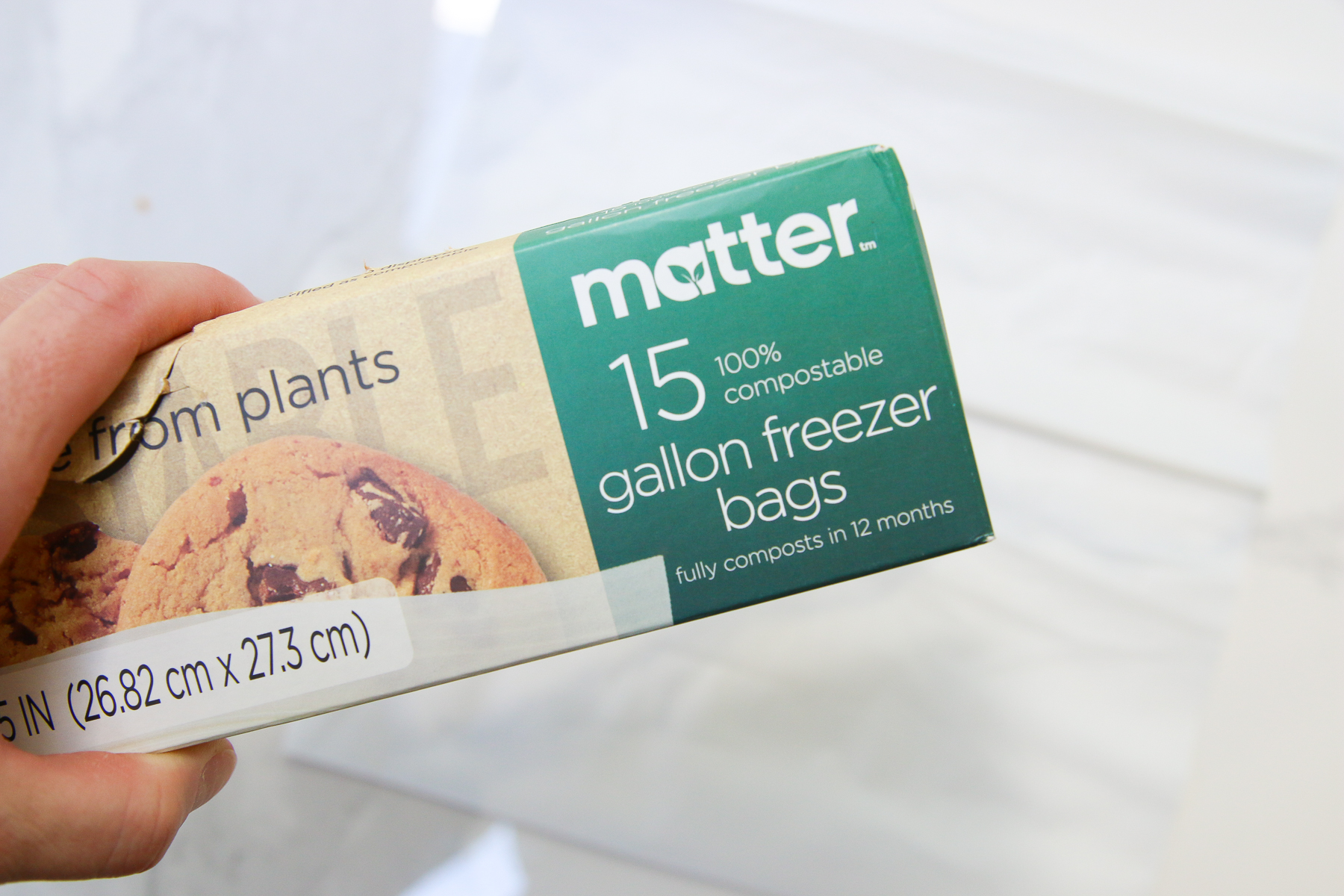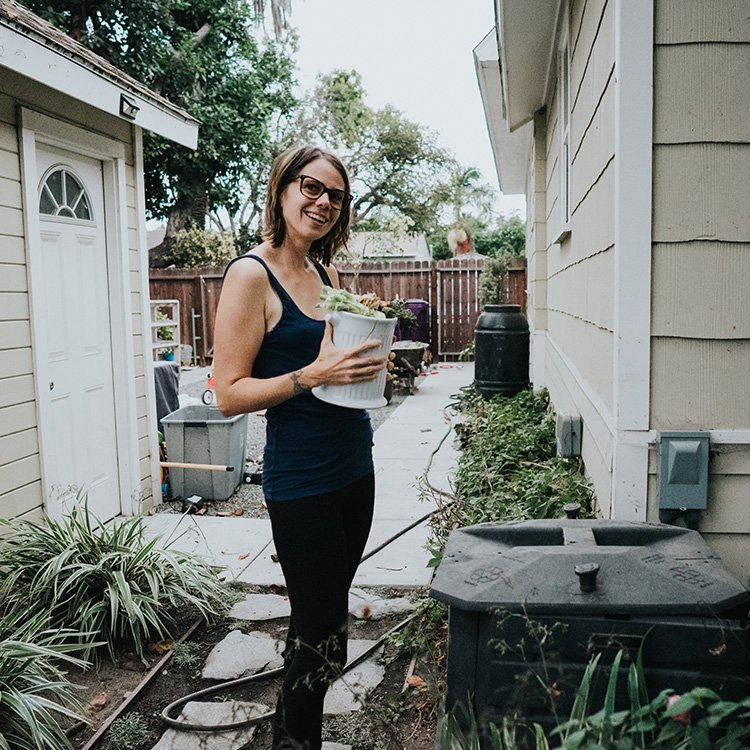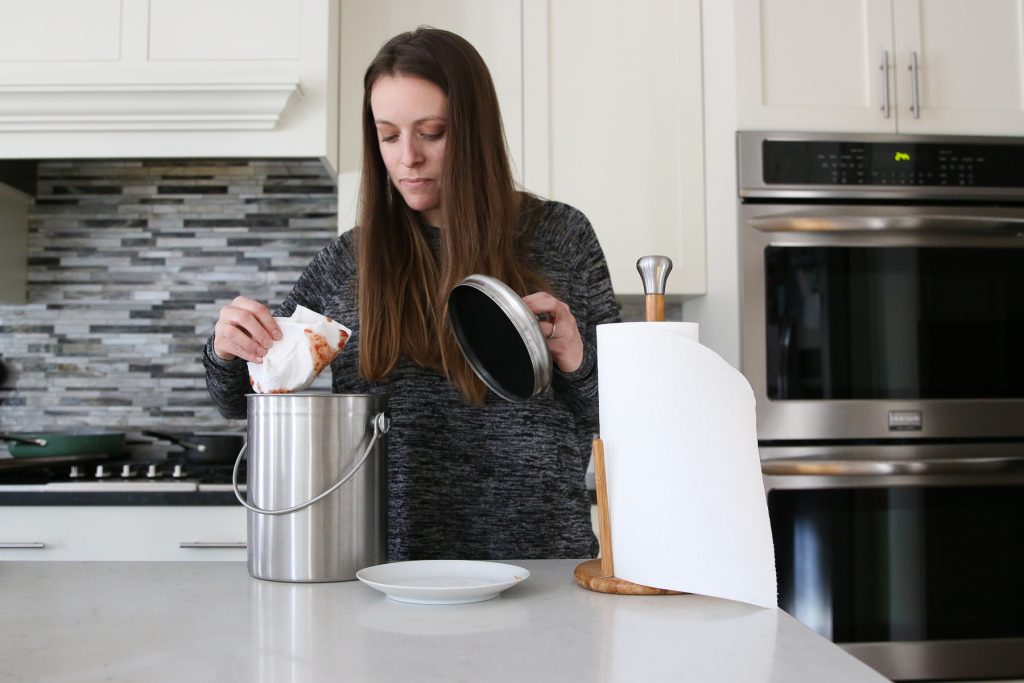Can You Compost Flowers?
What should you do with the wilting flowers after you’ve enjoyed their beauty? Can you compost flowers? Read on for more about whether or not your old flowers belong in the compost bin and what to consider when before tossing them in your compost bucket!

Flowers are so fun and colorful and a great way to brighten up a space. But I never used to have them in my house. I had no idea what to buy or how to arrange them. And they also felt like a gut punch to sustainable living when they’re grown with pesticides, shipped halfway across the world, stored in refrigerators for long periods of time, and wrapped in plastic.
Then I discovered a local flower farm near my house where I could get arranged bouquets through a subscription or their roadside flower stand in reused mason jars without the carbon footprint of transportation and extended refrigeration. I was sold.
Now we often have flowers gracing our kitchen counter or dining room table. They often last a couple of weeks before it’s time to replace them. And what’s a compost nerd to do with dying flowers? Compost them of course!

Can You Compost Flowers?
Have you ever wondered if you can compost flowers? Good news! You absolutely can, and it’s more beneficial than you might think. Composting flowers is not only an environmentally friendly way to dispose of them but also helps to create nutrient-rich compost for your garden.
You can compost fresh and old flowers. Fresh flowers (or recently fresh flowers that have seen better days) provide a great source of nitrogen to your compost heap. Over time, as flowers dry out, they lose some of their nitrogen content and have a relatively higher composition of carbon (more on this below). In either case, compost piles need nitrogen and carbon, so flowers make a great addition to the compost pile.
Depending on how you compost flowers (backyard bins, electric composters, commercial composting facilities, etc…), there are some additional considerations to keep in mind so you don’t contaminate a compost pile when, for example, flowers carry diseases or have been sprayed with pesticides.
To learn more about if you can compost flowers, let’s dive into a brief introduction to composting, how to compost flowers, and what special considerations to keep in mind to maintain a healthy compost pile to get that precious black gold.
What Is Composting?
Composting is a natural process where organic materials, such as plant waste and food scraps, break down into nutrient-rich soil amendments. This controlled, aerobic (oxygen-required) process occurs through natural decomposition, making it a sustainable and eco-friendly method to improve your garden’s soil.
When you compost, microorganisms like good bacteria and fungi feed on the materials added to the compost pile, breaking them down into a dark, crumbly, earthy-smelling product called compost. This finished compost is a fantastic source of nutrients for your plants and helps improve soil structure, contributing to healthier, more robust plants in your garden.
Some key components of a successful compost pile include a proper balance of green (nitrogen-rich) and brown (carbon-rich) materials, sufficient moisture, and adequate aeration. Flowers can be an excellent addition to your compost pile as they are rich in nutrients.

Benefits of Composting Flowers
Composting flowers, along with any other organic matter, offers numerous advantages, beginning with enriching your compost pile. By incorporating blooms into the mix, you supply essential nutrients that enhance the overall quality of your compost. Flowers, particularly fresh ones, contribute nitrogen which is vital for healthy soil and plant growth. This process not only helps you utilize waste but also promotes an environmentally friendly gardening practice.
Another benefit of composting flowers is the reduction in waste that goes to landfills. By using decomposing flowers in your compost pile, you contribute to a more sustainable and eco-friendly solution. Dead flowers, although no longer visually appealing, still have value and potential for reuse.
Adding composted flowers to your garden beds, window boxes, and container plants improves both the texture and structure of your soil. Healthy soil promotes better plant growth and root development, resulting in more productive and beautiful gardens.
Moreover, incorporating flower compost into your garden helps suppress diseases and pests. The beneficial microorganisms generated during the composting process can ward off harmful pathogens, creating a more balanced ecosystem for your plants.
Are Flowers a Compost “Green” or Compost “Brown”?
As you manage a compost pile, it’s helpful to know if flowers are compost greens (meaning they are higher in nitrogen) or compost browns (higher in carbon). A compost pile needs both of these elements, and the answer depends on the stage of the life cycle flower of the flower.
Fresh flowers (or slightly wilted flowers) are green compost material and high in nitrogen. Newly trimmed deadheaded flowers are also compost greens.
When flowers dry out, however, the nitrogen compounds that were present in the flower tissues begin to break down and undergo chemical changes. As a result, some of the nitrogen is lost to the atmosphere in the form of ammonia gas, while other nitrogen compounds may be converted into other forms or deposited in the soil as organic matter (for flowers living in the soil). Thus, older, dried flowers are relatively higher in carbon, after losing nitrogen, and are considered brown compost material.

How to Compost Flowers
There are various methods to compost flowers (or any organic matter, for that matter), and each has its advantages. No matter which method you use, you can compost all plant parts including the petals, stems, and leaves. However, it’s helpful to avoid composting seeds if you don’t want them to germinate in your finished usable compost and don’t have a hot composting system available that will kill the seeds during the decomposition process.
Let’s go through a few of the composting options available for composting flowers and discuss some of the benefits of each as well as some things to keep in mind. In particular, let’s discuss the speed and effectiveness of decomposition (particularly of potential pathogens from diseased plants or chemicals from flowers treated with pesticides and herbicides).

Backyard Flower Composting
Best Practices: Chop flowers, no diseased flowers, no flowers treated with pesticides or herbicides
Backyard composting is a traditional method that requires a designated space in your garden. When composting flowers using this method, you can add both fresh and dried flowers to your backyard compost bin or compost pile. Fresh flowers are considered “green” materials, while dried flowers are considered “brown” materials (as described above), contributing to a balanced compost mixture.
Backyard composting doesn’t always get as hot as some other types of composting. The lack of heat can slow down the decomposition process and result in a composting process that does not break down pathogens, pesticides, and herbicides. Therefore, it’s important to be cautious about adding diseased flowers or flowers that have been treated with pesticides and herbicides (such as most store-bought or commercial flowers) because these compost contaminants may not break down during decomposition.
Additionally, it’s helpful to cut the flower stems into smaller pieces to speed up the decomposition process. This is not necessary, but it creates more surface area on which microorganisms in the compost pile can break down the flowers to get finished compost.
Industrial Flower Composting
Best Practices: No need to chop flowers, diseased flowers and flowers treated with pesticides or herbicides are likely to be less problematic
Industrial composting is a large-scale composting process that is typically used by commercial operations, such as farms, food processing facilities, and municipal waste management facilities. Unlike home composting, which relies on natural biological processes to break down organic materials, industrial composting uses advanced technology and controlled conditions to accelerate the composting process and achieve rapid decomposition.
If you use a curbside composting service or have municipal composting available in your community, it’s likely your organic waste is brought to an industrial composting facility for processing. These systems are managed much more scientifically than most backyard compost bins and also reach higher temperatures. As it relates to composting flowers, these systems can more easily handle diseased flowers, weed seeds, or flowers sprayed with pesticides and herbicides.
In industrial composting, large volumes of organic materials, such as food waste, yard waste, and agricultural residues, are brought to a specialized facility or large compost pile where they are mixed together in a specific ratio to create a balanced composting recipe. The materials are then shredded, moistened, and placed in large, aerated composting bins or piles, where they are heated to high temperatures using specialized equipment and managed diligently.
The high temperatures achieved in industrial composting, typically between 131°F (55°C) and 160°F (71°C), are maintained for a period of several weeks to several months. These high temperatures help to rapidly break down the organic materials, including any pathogens, pesticides, or herbicides that may be present in the flower and other materials being composted. The composting process is also carefully monitored to ensure that the materials are aerated and moistened properly, which helps to promote the growth of beneficial bacteria and fungi that further break down the organic materials, including any harmful bacteria or chemicals.
Electric Composting for Flowers
Best Practices: Chop flowers, no diseased flowers, no flowers treated with pesticides or herbicides
An electric composter is a type of composter that uses electricity to speed up the composting process. Electric composters typically use a combination of heat, agitation, and aeration to break down organic materials, including flowers, into a potpourri type of dried organic matter.
You can put flowers in most electric composters, though be sure to follow the manufacturer’s instructions. Some of the machines suggest limiting the amount of fibrous material being processed in one cycle, and too many fibrous flower stems could get caught in the machine’s grinder. Cutting stems into smaller pieces or processing them over the course of a few cycles could help reduce any issues with processing.
Unlike industrial composting, it’s not guaranteed that these machines would kill any pathogens or break down pesticides and herbicides, so be cautious about putting these types of flowers into the electric composter if you’re planning to use the finished product as a soil amendment.

Vermicomposting for Flowers
Best Practices: Chop flowers, no diseased flowers, no flowers treated with pesticides or herbicides
In vermicomposting, worms play a crucial role in breaking down organic matter, including flowers. To start, you need a worm bin or container, bedding material (like shredded newspaper), and composting worms such as red wigglers or Eisenia fetida as they are efficient decomposers.
Add the flowers, along with other food scraps and “brown” materials, to the worm bin. It’s best to chop up the flowers into smaller pieces so their more surface area for the worms to break down the flowers and speed up the decomposition process. Be sure to avoid diseased flowers or those with chemical treatments if you’re vermicomposting. These will not be good for the worms in the bin.
The worms will consume the organic material and excrete nutrient-rich castings, which can be used as an excellent natural fertilizer for your garden. Regularly monitor the moisture levels and temperature inside the bin to maintain a comfortable environment for the worms.
Bokashi Composting for Flowers
Best Practices: Chop flowers, no diseased flowers, no flowers treated with pesticides or herbicides
Bokashi composting is an anaerobic process that uses beneficial microorganisms to ferment and break down organic materials. The process involves fermenting organic materials in an airtight container with the addition of a mixture of beneficial microbes, such as Lactobacillus. It requires a Bokashi bin, Bokashi bran (inoculated with microorganisms), and a tight-fitting lid to create anaerobic conditions.
To compost flowers with this method, chop them into small pieces and place them in the Bokashi bin. Sprinkle a layer of Bokashi bran over the flowers, then press down firmly using a plate or plastic bag to expel any air. Continue to add layers of flowers and bran until the bin is full, always remembering to press down firmly to eliminate oxygen.
Seal the bin tightly and allow the microorganisms to work for at least two weeks. After fermentation, you can either mix the Bokashi pre-compost with garden soil or add it to another composting method, like your backyard compost pile or worm bin, to further decompose and turn it into nutrient-rich, finished compost for your garden.
Bokashi composting can help to break down organic materials, including flowers, into nutrient-rich compost, but it may not necessarily break down all pathogens, pesticides, and herbicides. The Bokashi fermentation process can help to break down some organic compounds, but it may not be effective at breaking down all types of chemicals.
In particular, some pesticides and herbicides are designed to be persistent in the environment, meaning that they can remain in the soil or compost for a long time. While Bokashi composting can help to reduce the concentration of these chemicals, it may not necessarily break them down completely.
Furthermore, Bokashi composting is typically done in a closed system, which means that the compost may not be exposed to sufficient oxygen to fully break down some chemicals. For this reason, it’s generally recommended to avoid adding flowers that have been treated with pesticides or herbicides to a Bokashi composting system.
Overall, while Bokashi composting can be an effective way to compost flowers and other organic materials, it may not be the best option for breaking down all types of chemicals. If you’re concerned about the presence of pesticides or herbicides in your compost, it may be best to look into other composting methods or avoid composting these materials altogether.

Common Concerns with Flower Composting
As you consider composting flowers, there are some common concerns that may arise. Concerns relate to the types of flowers, how the flowers were grown, and other considerations.
Can You Compost Flowers with Pesticide and Herbicide Residues On Them?
When composting flowers, it’s essential to consider whether they have been treated with chemical-based pesticides or herbicides. These chemicals can contaminate your compost, potentially affecting plant growth and health.
As noted above, certain types of composting systems more effectively break down problematic chemicals that could contaminate the finished compost. If you’re concerned about pesticides and herbicides, be sure to use a composting method that gets hot enough to break down these chemicals.
To minimize this concern, also try sourcing flowers from organic sources or your own garden, where chemical use can be controlled. I’ve found local flower farms, where you can ask farmers about their growing processes, can be great avenues for finding such flowers. If you are unsure about the flower’s origins and don’t have access to hot composting, it’s best to avoid incorporating them into your compost.
Can You Compost Weed Seeds?
Weed seeds in decomposing flowers can lead to unwanted growth in your garden or compost pile. Hot or industrial composting processes will often kill weed seeds so they will not reproduce or grow in your finished compost. A cold compost pile, however, like most backyard composting, will not typically get hot enough to kill weed seeds and they could end up germinating in your amended soil.
To reduce this risk of invasive weeds and other unwanted plants in your compost, do not compost flowers with visible seeds or those that have gone to seed. Seeds can be difficult to eliminate once they have been introduced to the compost, so take preventive measures to ensure you are not inadvertently introducing weed seeds into your garden through the compost.
Can You Compost Diseased Flowers?
Composting is a great way to recycle organic materials, including garden flowers, and turn them into nutrient-rich soil that can be used to grow new plants. However, it’s important to keep in mind that not all flowers are suitable for composting, especially if they are diseased or contaminated with harmful fungi.
Diseased flowers or flowers with fungi on them can introduce harmful bacteria or fungal spores into your compost pile, which can then contaminate your soil and harm your plants. To avoid this, it’s best to avoid composting flowers that are clearly diseased or show signs of fungal infection (particularly if you don’t have access to hot composting or industrial composting). Instead, these flowers should be disposed of in the trash or burned, if possible.
However, it’s also important to note that not all fungi are harmful. In fact, many types of fungi are actually beneficial for composting, as they help break down organic materials and create nutrient-rich soil. So, if you’re not sure whether a flower with fungi on it is safe to compost, it’s a good idea to do some research or consult with a gardening expert to determine whether it’s safe to add to your compost pile.

Mix Flowers with Other Organic Matter
While most flowers are a great addition to a compost heap, finished compost is best when it includes a variety of compostable materials. Be sure to include many types of green waste and brown waste in your compost pile for the best soil amendment for your garden beds and green space.
Here are some other compost browns and compost greens to consider adding to your pile. This is not an exhaustive list, and you can find even more ideas about what organic matter to include in a compost pile in our “Can I Compost…?” Interactive Guide.
| Common Green Compost Material | Common Brown Compost Material |
| Coffee grounds | Wood ash or wood chips |
| Tea leaves | Lime |
| Strawberries | Eggshells |
| Banana peels | Straw bales |
| Tomatoes | Oyster shells |
| Grass clippings | Paper (ripped up or shredded) |
| Citrus peels | Cardboard (ripped up or shredded) |
| Blueberries | Dry leaves |
| Chicken Manure | Sawdust |
Composting to Complete the Nutrient Loop
Composting flowers is not only possible but also an excellent way to recycle and provide valuable nutrients to your garden soil. Both fresh and old flowers can be safely added to your compost pile, contributing essential nitrogen and other elements required for healthy plant growth.
However, it’s important to be mindful of flowers that may be contaminated by fungus or infected by diseases. As a precaution, do not include these in your backyard compost to avoid spreading harmful pathogens to your plants, or be sure your compost gets hot enough to kill off any pathogens or pesticides in your end product. Additionally, when composting poisonous plants and flowers, remember that their toxins get broken down during the decomposition process, making it safe to use the resulting compost in your garden.
To maximize the benefits of composting flowers, consider chopping them into smaller pieces to speed up decomposition. Using your nutrient-rich compost as a soil amendment or mulch can significantly improve the health and productivity of your plants, leading to a more vibrant and thriving garden.
Do you have any other questions about composting flowers? Let us know if the comments so we can do our best to help you out!


Jen Panaro
Jen Panaro, founder and editor-in-chief of Honestly Modern, is a self-proclaimed composting nerd and advocate for sustainable living for modern families. To find her latest work, subscribe to her newsletter, Stepping Stones.
In her spare time, she’s a serial library book borrower, a messy gardener, and a mom of two boys who spends a lot of time in hockey rinks and on baseball fields.
You can find more of her work at Raising Global Kidizens, an online space to help parents and caregivers raise the next generation of responsible global citizens.







